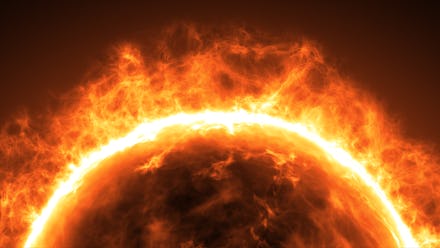Scientists are closer to figuring out why the sun shoots massive beams of plasma into space

The sun, impressive at it is, is much more complex than we tend to give it credit for. Of course we all know not to stare at it for long periods of time (well, most us do), and we know it's a flaming sphere of boiling plasma that will, unfortunately, eventually burn out, but there's still a lot of mystery in that fireball in the sky.
One thing you may not have realized is it's actually capable of creating "solar geysers" every so often, hosted by a solar phenomenon called sunspots. Recent research has uncovered additional information about these spots and how they perform, as well as the geysers they help form.
Sunspots are essentially areas of repeated ejection activity that violently push plasma far from the sun's surface. While this requires a high amount of magnetic energy to pull off, the sun can supply it in droves. Sunspots themselves are locations with concentrated magnetic activity, and they end up appearing as darker "blotchy" areas on the sun's surface. And while they may appear docile from our vantage point on earth, they are in fact massively chaotic, and capable of pushing energy so it hurtles from the sun's surface into space.
That means some spots have the ability to create the aforementioned "geysers" that launch jets of magnetic energy and plasma into the air much like the regular "Old Faithful," named due to its proclivity to erupt on what feels like a set schedule. Previously, scientists chalked this up to an excessive amount of magnetic energy simply destabilizing the environment surrounding the sunspot to create a jet over and over again.
Scientists also believed that occasional chaotic magnetic activity would sometimes cross paths over certain areas of the sun's surface. When this happened, the plasma beneath the crossed paths would explode and burst outward away from the surface, leading to those explosive geysers.
Both scenarios are valid theories by scientists who have been studying the phenomena for quite some time, with no clear-cut answer as to which fully explained what was going on. Now, thanks to a new paper published in The Astrophysical Journal, it seems that there isn't any real reason to choose. Either one of the answers could potentially occur at any time within different situations.
A team identified 10 geysers that had sprouted on the sun in 24 hours, examined the buildup of each blast, and then compared them to predictive models they had produced of either the "cancellation" with paths crossing scenario and the "emergence" scenario with magnetic buildup. It seemed that the results were often split.
While of course this doesn't offer a definitive answer to which is more prominent, it does give scientists something interesting to dwell on: namely, the idea that some happenings in space occur as the result of various stimuli. In general, there doesn't have to be one explanation for even the most bizarre phenomenon out there in space. Perhaps there are multiple ways to explain how black holes end up forming, or even, at some point, the mysteries behind dark matter. Knowing that there are a multitude of ways to understand something as simple as why geysers form on the surface of the sun gives researchers a new way to approach lining out explanations like these in the future with other happenings as well. It also means a new reason to continue investigating the strange, fascinating mysteries of our own solar system, even the ones that feel a bit too obtuse to ever really parse.